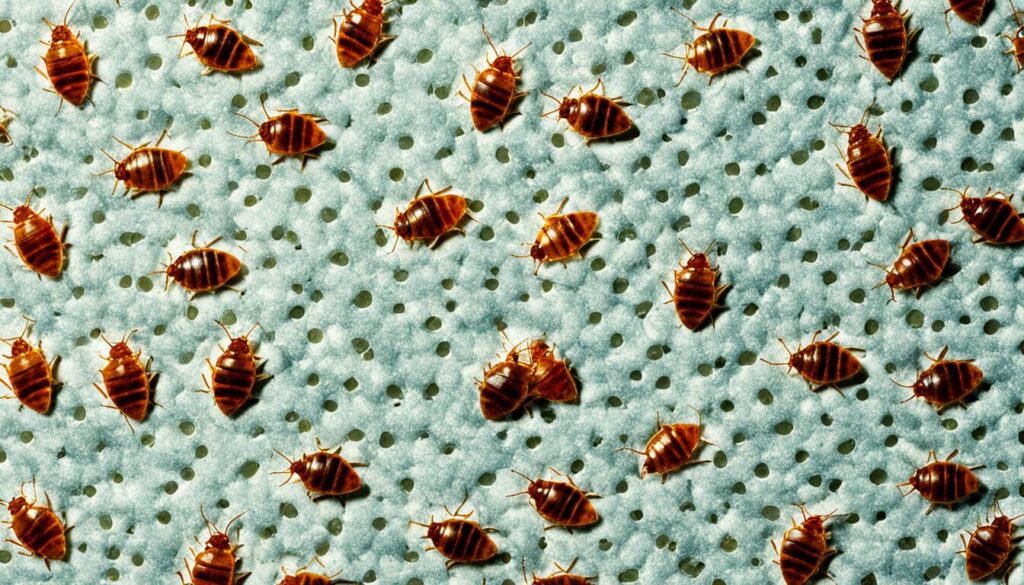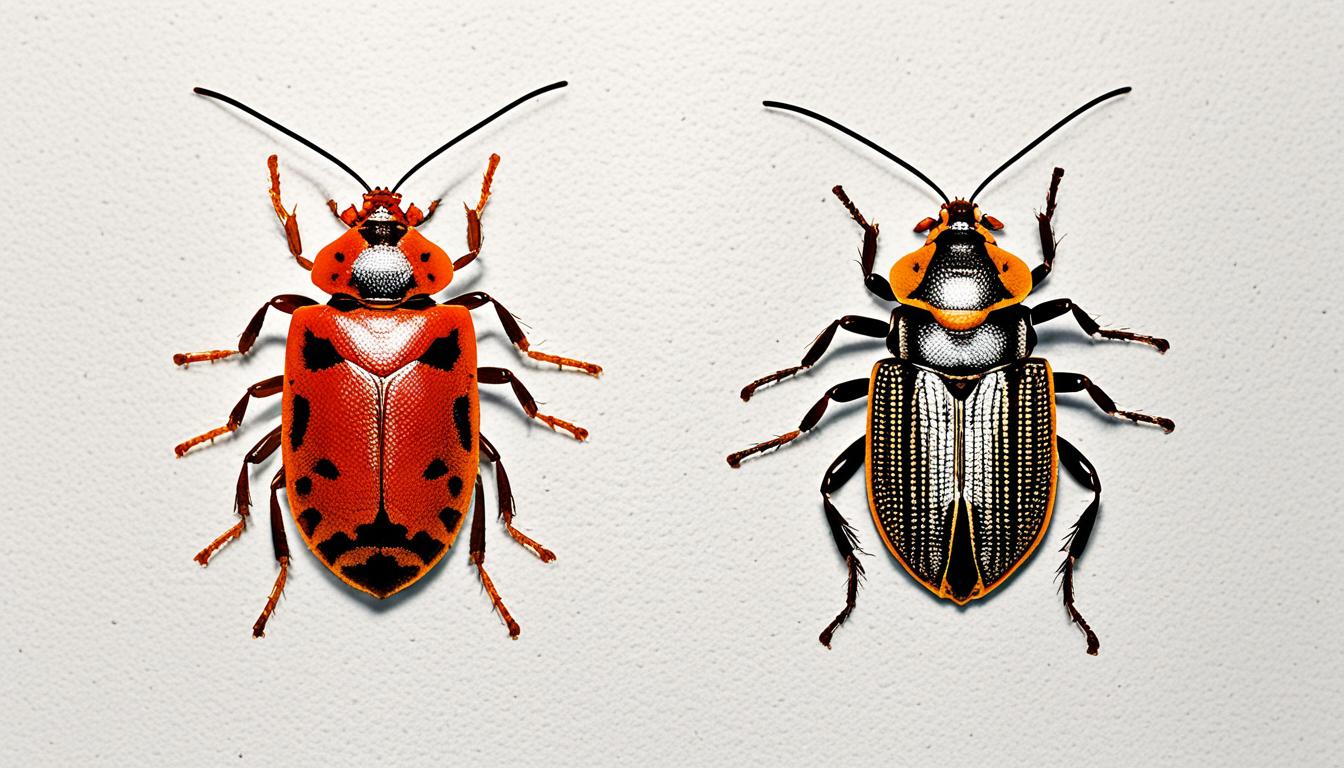Bed Bug Shells: What You Need to Know
Disclaimer: This post may contain affiliate links. As an Amazon Associate, we earn from qualifying purchases.
Ever seen light brown or translucent shells around your home? These could be signs of bed bug infestation. Bed bug shells, or casings, show you might have bed bugs. Knowing about these signs helps spot infestations early and control them better. Bed bugs shed their skins as they grow, leaving behind shells that show how bad the infestation is. This article will explain bed bug shells and their importance in controlling bed bugs.
Key Takeaways
- Bed bug shells indicate growth and ongoing activity within an infestation.
- They are commonly found in areas where bed bugs hide, like mattress seams.
- Early identification of shells is key to mitigating serious infestations.
- Bed bugs can shed their exoskeleton up to five times before reaching adulthood.
- Prompt action is necessary when discovering bed bug shells in your home.
Introduction to Bed Bugs
Bed bugs are tiny insects that feed on blood. They are scientifically known as Cimex lectularius. These pests live in places where they can easily find humans, like mattress seams and furniture cracks. They bite humans at night but can bite during the day too if they need to.
A single female bed bug can lay up to 113 eggs in her life. This leads to a fast increase in their numbers. Under the right conditions, bed bug populations can grow by half every 16 days. This makes it important to act fast if you find bed bugs.
Bed bugs have become more common in the U.S. and around the world since the late 1990s. Even though they don’t spread diseases, their bites can cause itching and allergic reactions. About 30% of people don’t react to bed bug bites, making it hard to know if you have an infestation.
Bed bugs can live for months without eating and can survive in cold temperatures. This means you need regular pest control to stop and manage infestations.
What are Bed Bug Shells?
Learning about bed bug shells helps us understand these pests better. These shells, or exoskeletons, appear as bed bugs grow and shed their skin. Spotting these shells can warn people of bed bug infestations.
Understanding Their Exoskeletons
Bed bug shells are the exoskeletons left behind after they molt. This hard outer layer protects them as they grow. Bed bugs go through five stages before becoming adults, shedding their skins at each stage.
These shells are usually translucent and may look brownish from their previous blood meals. They clearly show signs of bed bug activity.
How Bed Bugs Grow and Shed
Bed bugs grow in a unique way. Female adults can lay hundreds of eggs, leading to more infestations. They go through five stages, from 1.5 mm to about 4.5 mm in size.
After each stage, they shed their skins, leaving behind empty shells. Finding these shells is important because it means these pests are likely around.
Signs of Bed Bugs in Your Home
Knowing the signs of bed bugs is key to keeping your home comfy. Spotting them early can stop a small problem from getting bigger. A common first sign is bed bug bites. These bites might be hard to see at first, especially if you don’t react to them.
Recognizing Bed Bug Bites
Bed bug bites look like clusters and can be mistaken for other bites or skin issues. They can cause redness, welts, or blisters. Knowing what bed bug bites look like helps you catch them early. About 30% of people don’t show any signs of being bitten.
The Importance of Early Detection
Finding bed bugs early saves money and effort to get rid of them. Look out for bed bug shells, dark spots, and rusty stains on your bedding. Bed bugs shed their skins often before they grow up, so finding their shells is easier. Being alert can help you act fast and keep your home comfy.
Where to Find Bed Bug Shells
Finding bed bug shells means looking closely and knowing where they like to hide. These pests often hide in spots close to where they feed. Knowing where to search can stop infestations early.
Common Hiding Spots
Bed bugs prefer places that give them shelter and are near their food. Common spots include:
- The seams of mattresses
- Edges of box springs
- Behind headboards
- In the crevices of furniture
- Along baseboards
- Underneath rugs and carpets
- Inside dresser drawers
- Along the edges of curtains
- In luggage after travel
Identifying Clusters of Casings
As bed bugs grow, they shed their skins, leaving behind shells. Finding these shells in groups is a sign of a big problem. Look for:
- Clusters of casings along mattress seams
- Concentrated areas in furniture cracks or corners
- Presence of multiple shells in high-traffic areas like couches
Checking these spots helps you understand how bad the infestation is. The more shells you see, the more bed bugs there likely are.

Identifying Bed Bug Infestation
Spotting signs of bed bugs is key to tackling the problem early. Seeing live bugs, fecal stains, or blood spots on your bedding are clear signs. Identifying bed bugs early can stop a bigger issue.
Other Indicators of a Problem
Other signs can also point to bed bug issues. Look for:
- Live bugs, which vary in size from 4 to 7 mm, resembling the size of a flaxseed.
- Fecal stains that can appear as dark spots and may run red when moistened.
- Blood marks on sheets, often the result of bed bug bites.
Knowing these signs helps in spotting bed bug infestations better.
Distinguishing Between Shells and Live Bugs
It’s crucial to know the difference between bed bug shells and live bugs. Shells are brown or transparent and left after the bugs molt. They can look like live bugs but are bigger and oval in shape. Spotting live bugs shows there’s ongoing breeding and feeding.
Live bugs are hard to see because they move fast and hide well. Always check for all signs to spot a possible infestation.
What to Do When You Find Bed Bug Shells
Finding bed bug shells can be scary, but acting fast is key. These shells mean bed bugs have been in your home. Quick action can help stop more bugs from coming.
Immediate Cleaning Tips
Start with these steps if you find bed bug shells:
- Vacuum where the shells are found, paying attention to mattress seams and small spots in furniture and baseboards. Make sure to throw away the vacuum bag sealed to stop bugs from spreading.
- Wash all your bedding, clothes, and linens in hot water. This kills any bugs or eggs left behind.
- Seal up any cracks in walls and furniture to cut down on hiding places for bugs.

When to Call Pest Control
If you keep finding shells after cleaning, or if the problem looks big, call a pest control expert. Companies like Brady Pest Control in Grand Prairie, TX, offer great bed bug solutions. They use heat and specific insecticides. These pros will look at your situation and make a plan to get rid of the bugs for good. They’ll also help stop them from coming back. For more info on bed bugs, check this resource.
Bed Bug Casings vs. Live Bed Bugs
Knowing the difference between bed bug casings and live bugs helps spot an infestation. Bed bug casings are the skins they leave behind when they grow. They look pale or translucent and are oval-shaped, measuring 1.5-2mm. People might mistake these for other debris like carpet beetle skins or lint.
Live bed bugs have their own signs. They are darker and live in groups near mattresses and furniture. They need blood to grow and reproduce. A female can lay up to 500 eggs, making the problem worse.
Looking closely can tell you how bad the infestation is. Seeing many casings means there are a lot of bugs. It’s important to find both casings and live bugs in infested spots. Experts suggest checking for both to tackle the problem well.
Cleaning helps stop the infestation from getting worse. Use a vacuum, wash bedding in hot water, and steam carpets to help.
| Observation | Bed Bug Casings | Live Bed Bugs |
|---|---|---|
| Appearance | Pale or translucent, often oval | Darker color, usually brown or reddish |
| Size | 1/16 inch to 3/8 inches | Up to 1/4 inch (fully grown) |
| Location | Commonly in mattress seams, bed frames, furniture | Gathered in groups near feeding sites |
| Lifecycle Stage | Shed skins representing different development stages | Adults and nymphs at various growth stages |
| Significance | Indicator of infestation severity | Active pests needing immediate attention |
Health Risks Associated with Bed Bugs
Bed bugs don’t spread diseases, but they can still cause health problems. People bitten by them might get allergic reactions. This can lead to skin issues, rashes, and sometimes, infections from scratching too much.
This can make everyday life tough, causing ongoing discomfort and unease.
Allergies and Asthma Symptoms
Being stressed about bed bugs can also make health conditions worse, especially asthma. Asthma symptoms might get worse due to the stress of dealing with bed bugs. This can cause more wheezing and trouble breathing.
It’s important to know about these risks. Taking steps to deal with bed bugs early can protect your health and well-being.
In short, bed bugs can cause allergies and make asthma symptoms worse. It’s crucial to act fast to reduce health risks.






